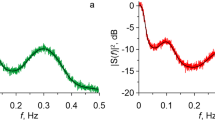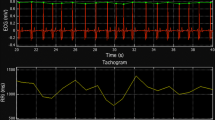Abstract
Frequency domain representation of a short-term heart-rate time series (HRTS) signal is a popular method for evaluating the cardiovascular control system. The spectral parameters, viz. percentage power in low frequency band (%PLF), percentage power in high frequency band (%PHF), power ratio of low frequency to high frequency (PRLH), peak power ratio of low frequency to high frequency (PPRLH) and total power (TP) are extrapolated from the averaged power spectrum of twenty-five healthy subjects, and 16 acute anterior-wall and nine acute inferior-wall myocardial infarction (MI) patients. It is observed that parasympathetic activity predominates in healthy subjects. From this observation we conclude that during acute myocardial infarction, the anterior wall MI has stimulated sympathetic activity, while the acute inferior wall MI has stimulated parasympathetic activity. Results obtained from ARMA-based analysis of heart-rate time series signals are capable of complementing the clinical examination results.
Similar content being viewed by others
References
Baselli G, Cerutti S, Civardi S, Lombardi F, Malliani A, Merri M, Pagani M, Rizzo G 1987 Heart-rate variability signal processing: quantitative approach as an aid to diagnosis in cardiovascular pathologies.Int. J. Biomed. Comput. 51–70
Kay S M 1988Modern spectral estimation: Theory and application (Englewood Cliffs, NJ: Prentice Hall) pp 17–33
Marple S LDigital analysis with applications (Englewood Cliffs, NJ: Prentice Hall)
Naidu VPS, Bindu E, Mahalakshmi P, Reddy MRS 1999 Spectral analy of heart-rate variability in myocardial infected patients.Int. conf. on Medical Diagnostic Techniques and Procedures, IIT Madras, Chennai, pp 76–81
Naidu VPS, Bindu E, Reddy MRS 2000 A high precision R-point detection algorithm.Trends Biomater. Artif. Organs vol. 14: 5–8
Natalucci S, Ruggeri P, Picchio V, C E Cogo, Burattini R 1999a Parametric analysis of heart-rate variability in anaesthetic SHR and WHY rats.Comput. Cardiol. 591–594
Natalucci S, Ruggeri P, Picchio V, Cogo C E, Burattni R 1999b Parametric analysis of heart-rate variability in anaesthetic SHR and WKY rats.Comput. Cardiol. : 591–594
Pagani M,et al 1976 Power spectral analysis of heart-rate and arterial pressure variabilities as a marker of sympatho-vagal interaction in man and conscious dog.Circ. Res. 49: 178–193
Pinna G, Orsi G, Corsio G 1992 Effect of record length on power spectral estimation of heart-rate variability signal.Comput. cardiol. 261–264
Author information
Authors and Affiliations
Rights and permissions
About this article
Cite this article
Naidu, V.P.S., Reddy, M.R.S. Time-variant power spectral analysis of heart-rate time series by autoregressive moving average (ARMA) method. Sadhana 28, 1027–1035 (2003). https://doi.org/10.1007/BF02703813
Received:
Revised:
Issue Date:
DOI: https://doi.org/10.1007/BF02703813




